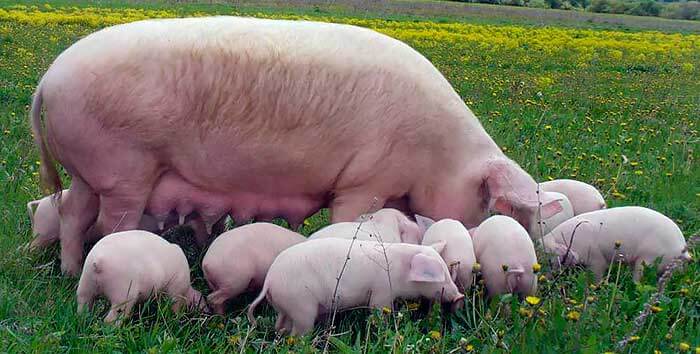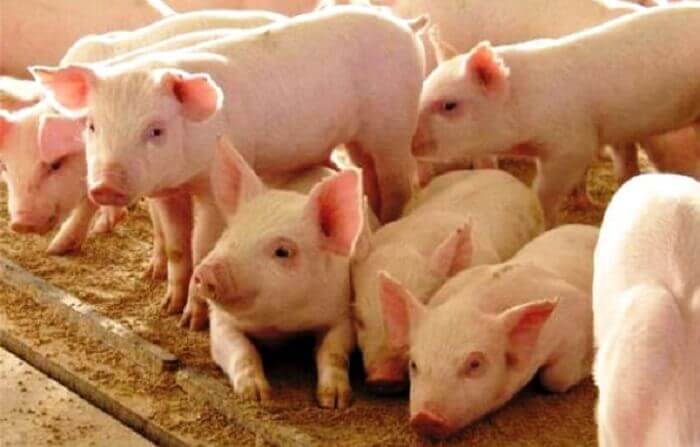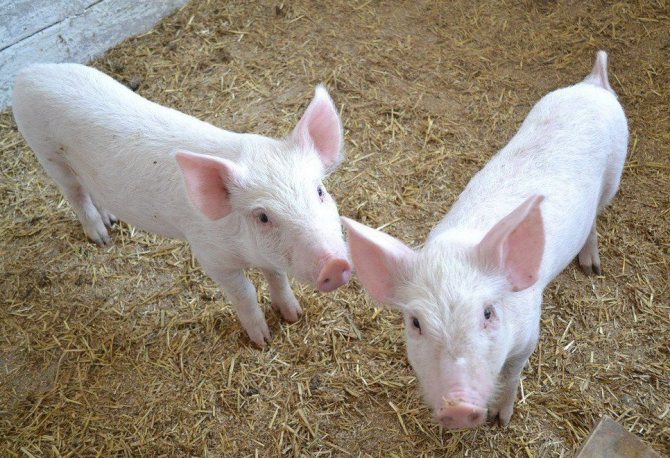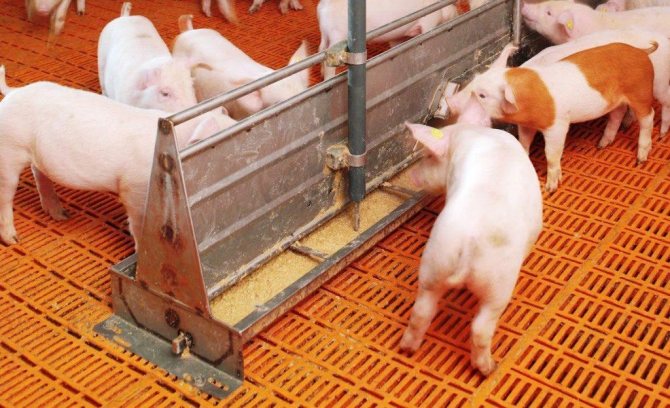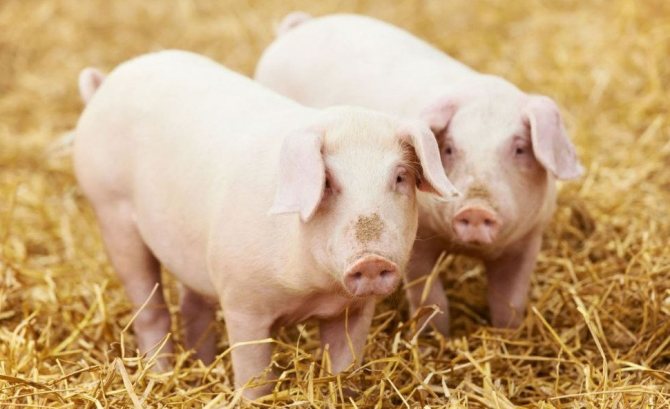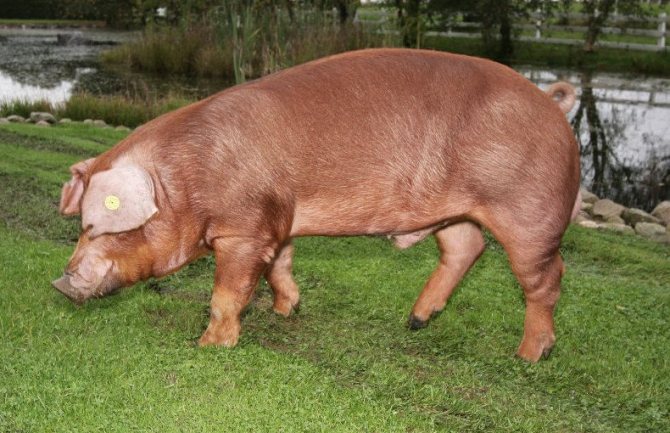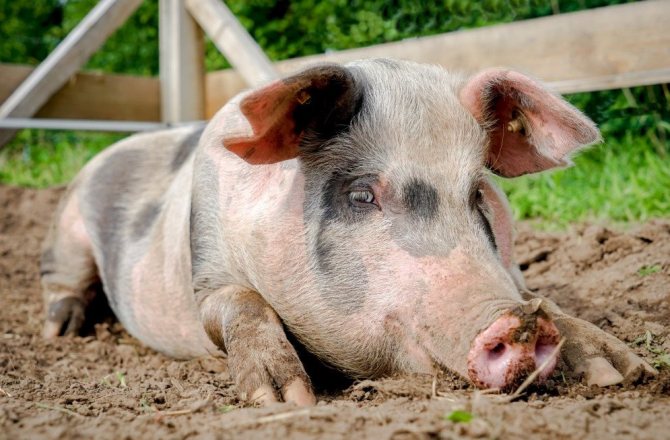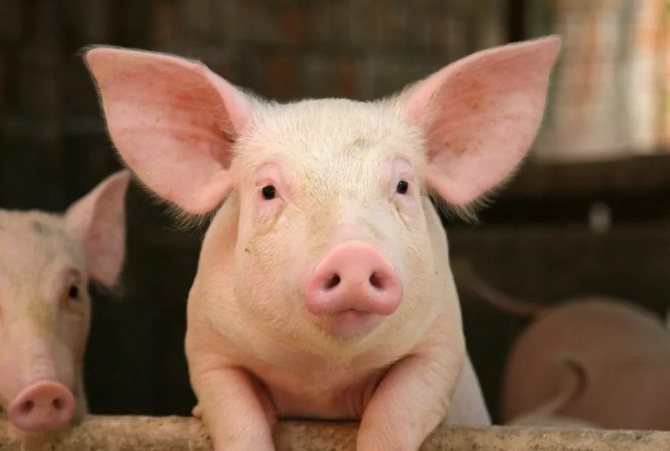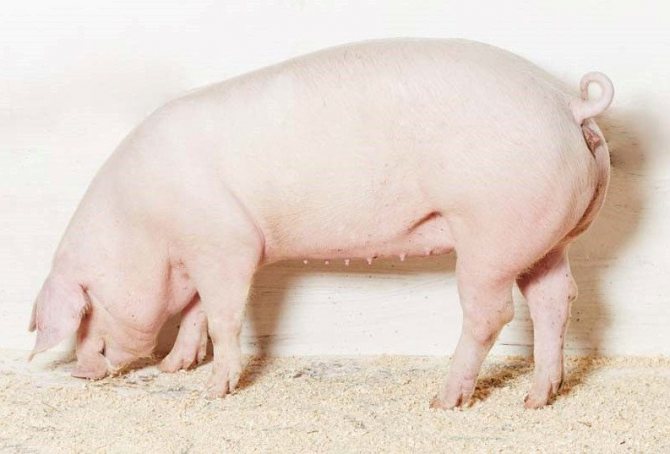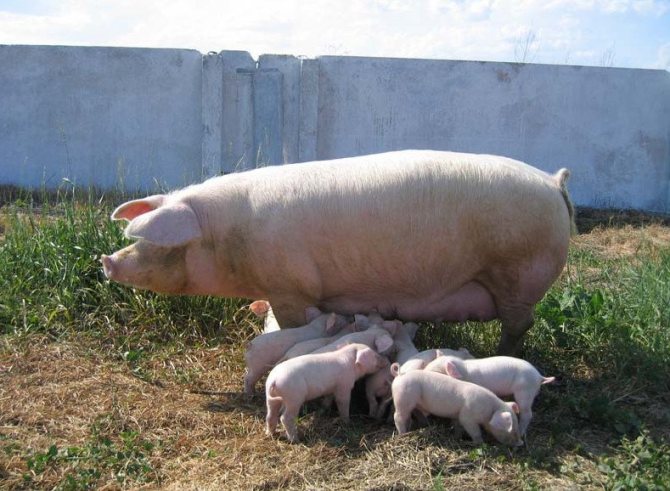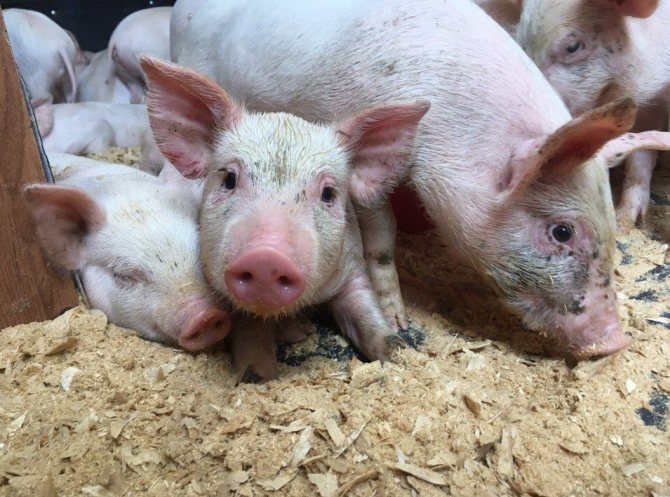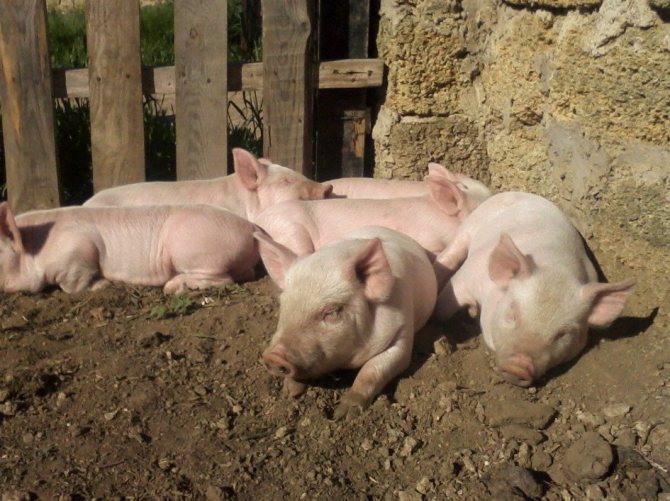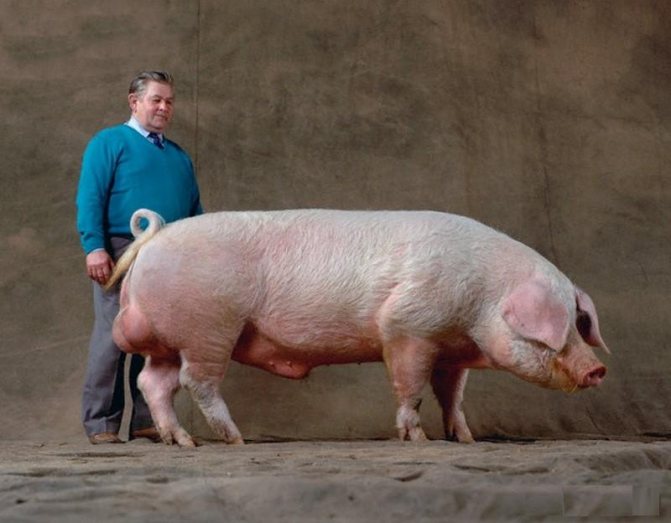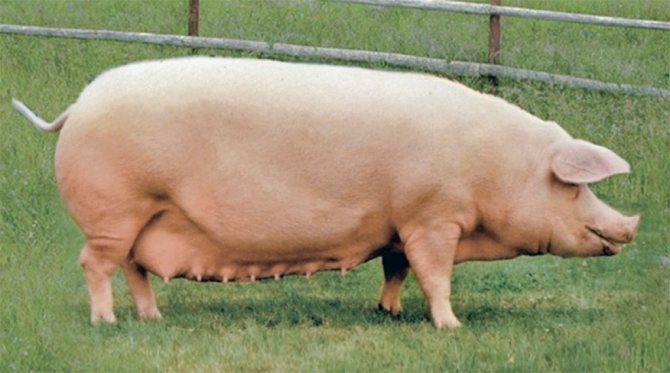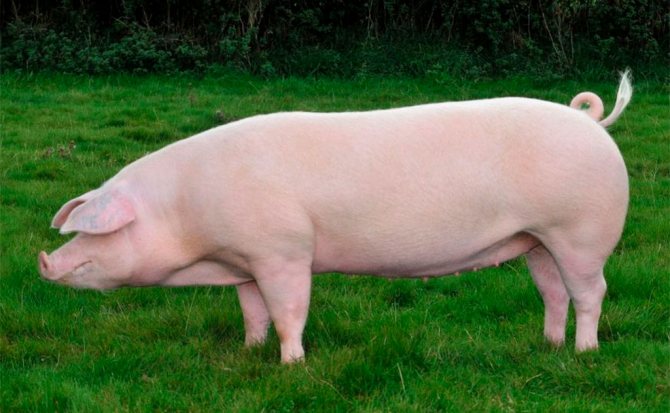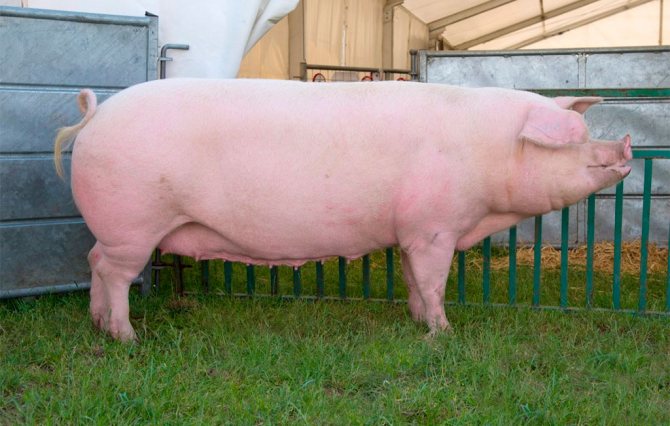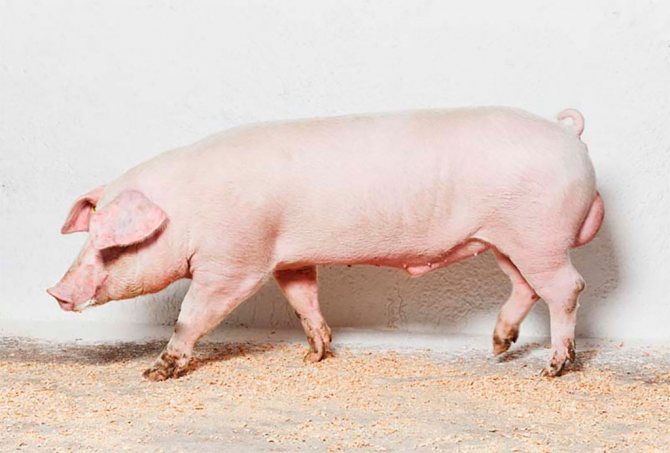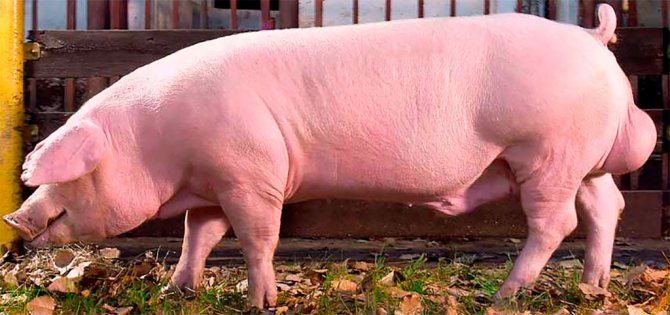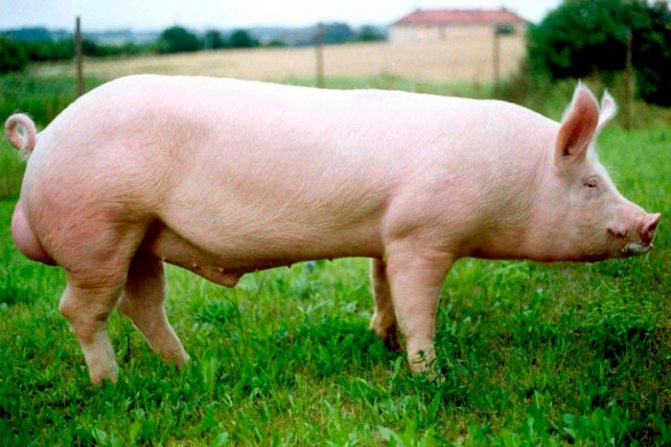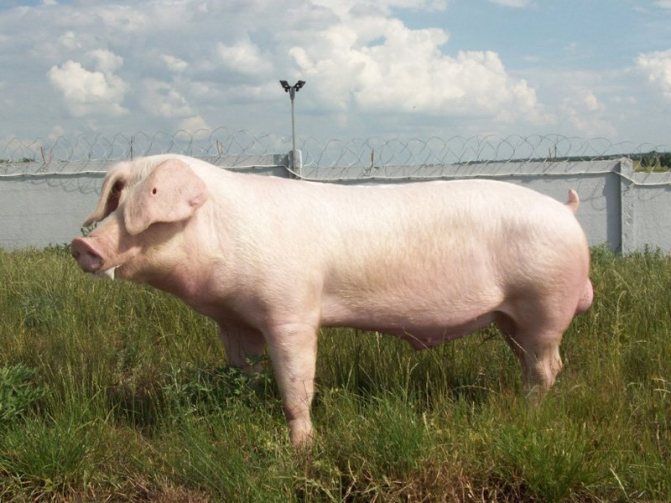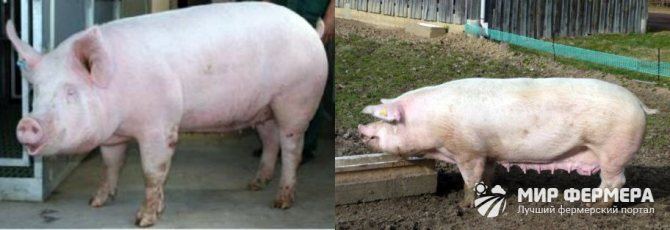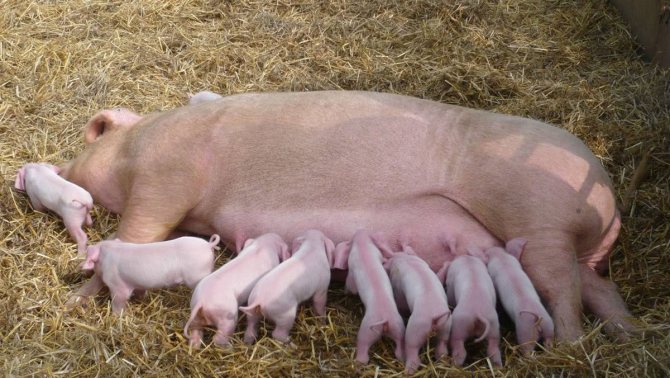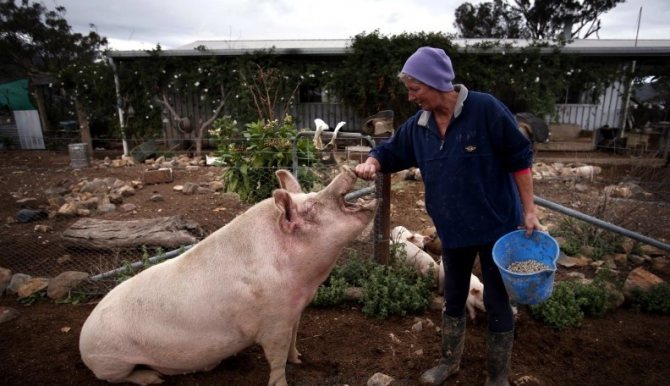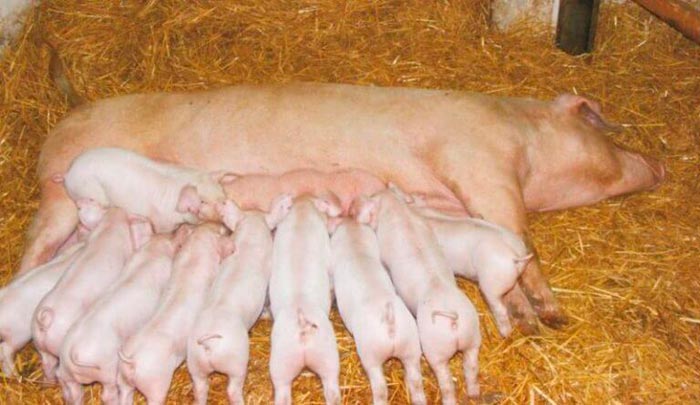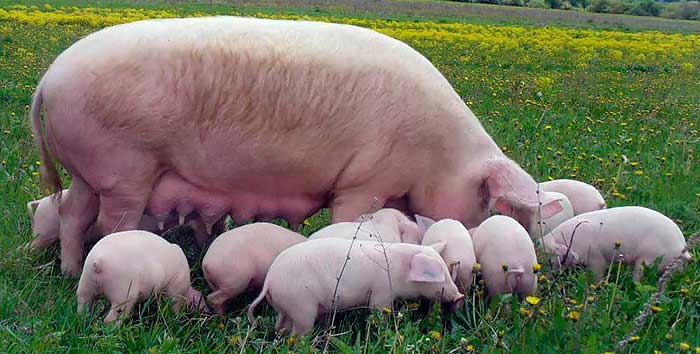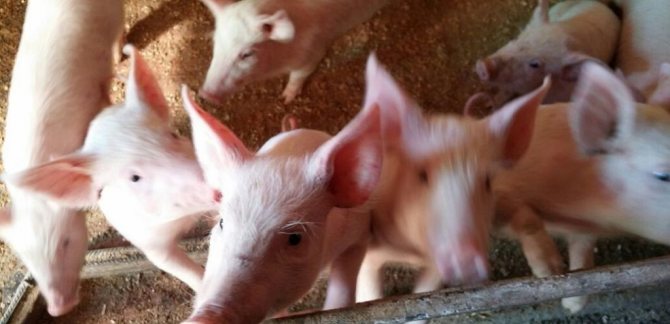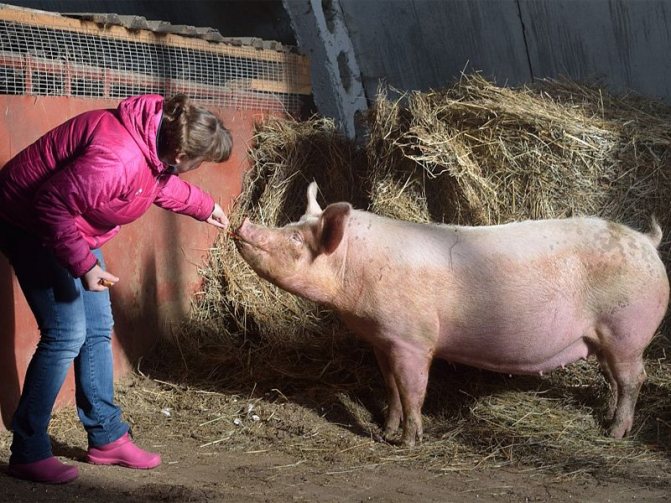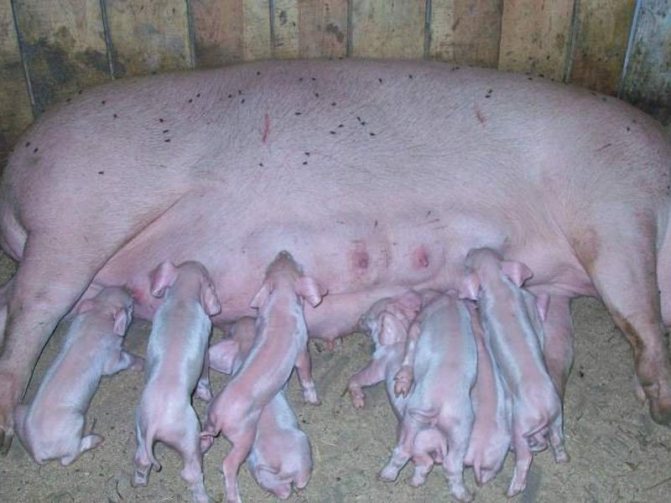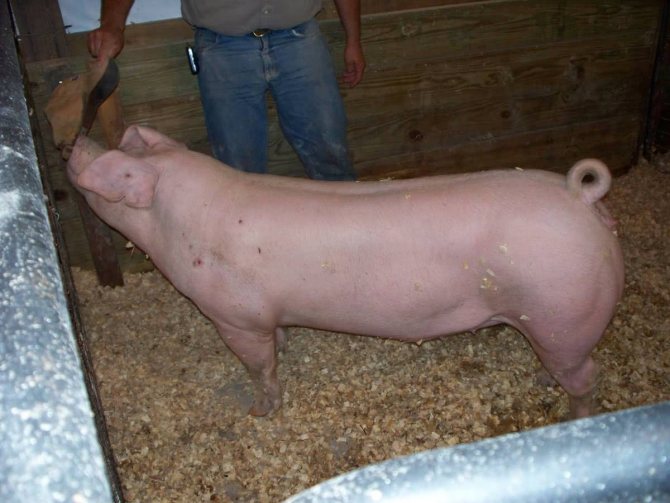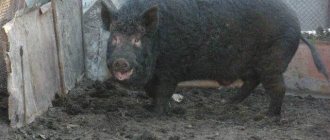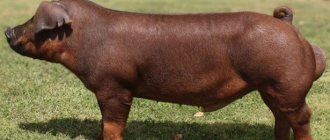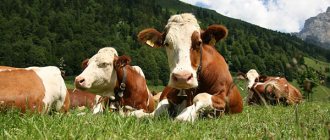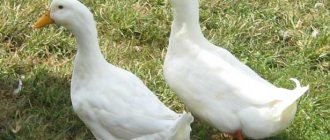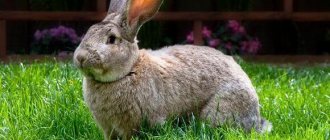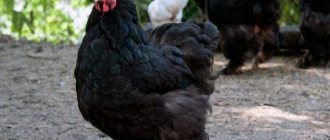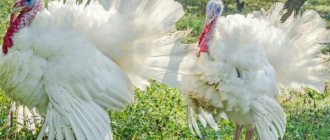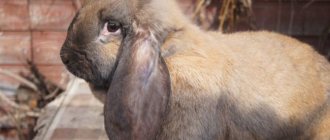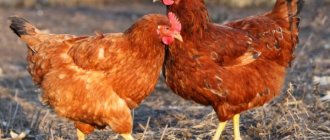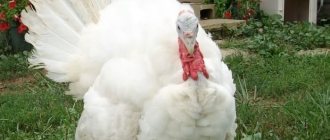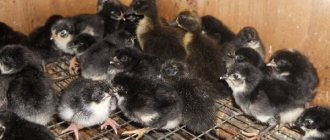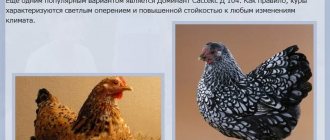History of appearance
Landrace pigs appeared in the late 19th century as a result of crossing Danish and English white pigs. The breed has been tested for 10 years.
Thanks to the pedigree piglets, Denmark has become one of the largest European suppliers of bacon to the world market.
For some time the export of live animals was banned, but in 1940 the ban was lifted and purebred pigs were popular in many countries.
Purebred Landrace have disadvantages. They have a weak cheek, and there are also problems with the hind limbs. In other countries, piglets are crossed with other breeds. This allows you to get healthy and strong offspring. Hybrids have the best qualities of Landrace and do not have the disadvantages of purebred animals.
Origin and registration
Landrace was bred in Denmark at the turn of the 19th and 20th centuries by crossing local pigs such as European folds with large white and Berkshire pigs, imported mainly from Great Britain, followed by a long selection. As a result of breeding work, it was possible to obtain animals of the meat (or rather, bacon) direction, which have metabolic features that allow them to accumulate a moderate amount of fat, assimilate feed well and quickly build muscle mass.
The breed first came to our country in 1948, but did not become widespread due to some difficulties in keeping. Breeding and acclimatization were carried out by two large tribes (Novgorod region) and them. Tsvetkova (Kaluga region). Only from the 3-4th generations, obtained by intrabreed crossing, did the specialists manage to create rather consolidated herds. In 1993, the breed was officially registered in the State Register as allowed for cultivation in all regions of Russia.
Landrace is widely used in crossing and hybridization as a father or third breed.
Now many owners of private farms and large meat producers have begun to take an active interest in it.
Characteristics and features
Landrace pigs have a strong constitution and meaty forms. The length of the boars is 2 m, the girth of the chest is 1.5 m. The length of the sows is 1.6 m, the girth of the chest is the same as that of the boars. Pigs have a lively character, good appetite. They are quite mobile. Not aggressive and friendly to humans. They have good meat characteristics. By the description, you can easily recognize the Landrace breed and not be confused with other breeds.
A feature of Landrace is an elongated body.
Possible diseases and their prevention
In pigsties, disinfection is carried out 2-4 times a year. One procedure lasts from 3 to 5 days. Spore-forming microorganisms are destroyed with solutions of active chlorine (5%) or formaldehyde (4%). For an area of 1 m², 3 liters of disinfectant are consumed.
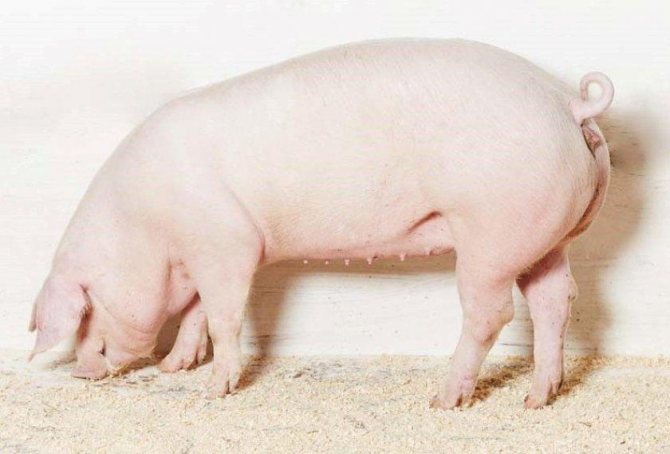
Common diseases of Landrace pigs:
- scabies;
- erysipelas;
- ringworm;
- plague;
- cysticercosis;
- dysentery.
Sick animals are isolated, treatment is carried out under the supervision of a veterinarian. The infection is carried by rats, mice, insects. Infection vectors are fought in two ways:
- deratization is carried out from rodents, mice and rats are poisoned with poisons (monofluorin, bactocoumarin, zinc phosphide);
- from flies, ticks, lice, fleas, pigs are rescued using pest control, the pigsty is sprayed with chlorophos.
To prevent disease, piglets are vaccinated. The first vaccinations against colibacillosis, salmonellosis are given on the 3rd day. At the age of 1.5 months, they are vaccinated against leptosporiasis. Piglets are vaccinated against this disease twice at weekly intervals. The vaccine against erysipelas is given to piglets at 2 months of age, and against plague - at 3 months. Vitamins are prescribed to pigs in the first week of life.
Appearance
The Landrace breed has the following appearance:
- Long torpedo-shaped torso.
- Small head. Small drooping ears that cover the eyes.
- Long, fleshy neck.
- Powerful body.
- Straight back, narrow chest.
- Meaty hams.
- Strong short legs.
- White, short, sparse coat, through which pink thin skin is visible.
There are animals with a white and black color, but this is not an indicator of the breed defect. The Landrace boar has a longer and more powerful body than a sow and can reach 300 kg.
Productive qualities
Landrace meat breed is considered early maturing.
Landrace plants do not store fat, so the pork is lean. The meat yield is 70%.
The productivity of animals depends on nutrition and proper care.
The weight of 2 month old piglets is 20 kg. With proper nutrition and care, they gain weight from 650 to 700 grams every day. The weight of a 6-month-old animal is 100 kg. The maximum pig weight reaches 300 kg.
The rapid weight gain and development of pigs saves on feed and increases the level of profitability.
Sows are fertile. For 1 farrowing they produce from 10 to 12 piglets. They have a developed maternal instinct and a high level of milkiness.
Advantages and disadvantages of Landrace pigs
Although these pigs are very popular throughout almost the entire northern hemisphere, including in Russia, they are quite far from ideal. Along with the obvious advantages, the characteristic of the Landrace pig breed also includes significant disadvantages, which may well become a valid reason to avoid them when choosing the main breed for the livestock being raised. According to farmers, the main advantages of Landrace are:
- Low in subcutaneous fat. If your farm is focused specifically on obtaining meat, including bacon, then this breed is perfect. Cheap offal make up a relatively small portion of the carcass.
- Good early maturity. Young animals show excellent daily gains at a fairly low feed consumption per kilogram of gain. By strictly observing all the rules for keeping and feeding Landrace pigs, you can have a very decent profitability of raising them.
- High fertility. On average, one sow produces about 10 piglets, but often 11-12 piglets, which is a very good indicator.
- Peaceful character. Although these pigs are quite active and mobile, they are not particularly aggressive. They get along well with each other and obey the person.
With all these advantages, many farmers, nevertheless, prefer to bypass this breed, preferring less fertile and productive, but easier to care for and maintain breeds. Most often, Landrace is scolded for:
- Demanding to the conditions of detention. It is worth violating at least one of the conditions for keeping pigs (composition of feed, temperature in the pigsty, light level, cleanliness, humidity, room area per head, etc.), as this will immediately affect the productivity of animals.
- Finicky food. Even taking into account the fact that the composition of the feed must be strictly balanced in terms of nutrient content, the pigs can also be capricious, simply refusing the food offered to them.Then you have to feed the Landrace pigs almost forcibly.
Breeding
To breed Landrace piglets, you should find a boar in advance, since the duration of sexual hunt is 2 days. During this time, the boar must cover the sow 2 times with a break of 12 hours. To obtain healthy offspring, you need to carefully select a boar.
The inseminator should be kept in good conditions, in a spacious pigsty with outdoor walks. The boar should be fed with quality food.
It is necessary to feed the pregnant uterus with high-quality feed. They must not contain rot and mold, as poor food can lead to the death of embryos. Gestation lasts 115 days. Piglets are born weighing 1.6 kg.
It is recommended that the farrowing takes place under the supervision of a veterinarian, as complications may occur in large queens.
During the first 40 minutes of life, piglets should be attached to the udder. Weak newborns need to be applied to the front nipples, because they have more milk. Piglets get their first immunity with mother's milk.
Some sows may behave aggressively, so the piglets need to be separated. An important condition for keeping newborn animals is cleanliness, warmth and dryness.
Content
To grow Landrace piglets, they must be properly maintained and fed. Deviation from the rules of keeping leads to health problems and reduced performance of pigs.
The cultivation of such a breed requires special conditions of detention:
- Drafts should not be allowed in the room where Landrace is kept.
- The temperature should be 20-22 ˚С.
- Dry litter.
- Compliance with hygienic conditions.
- Providing lighting. A combination of natural and artificial lighting is recommended. 5 part of the area of the walls of the room should be glazed.
- Walked piglets. Accuracy of the content leads to disease. The parts of the pigsty should be spacious.
- Animals should be bathed in warm water.
- Vaccination. Piglets need to be vaccinated against various diseases.
Due to changes in housing conditions or diet, loss of weight gain, a drop in livestock may occur. The health of the piglet can be affected by climate change and relocation to a smaller pen.
Landrace does not tolerate the open sun. Therefore, you should take care of the walking area, it should have a canopy that protects from the sun and rain.
It is not advisable to keep 2 sows in one pen. During the hunt, they bother each other and can show aggression. This can affect their weight and feed efficiency.
Pigs should be kept on deep, permanent bedding. Straw is often used. You can also use a fermentation bed to which live lactic acid bacteria are added. In such a litter, the waste products of piglets are broken down, as in a dry closet.
Young animals should be checked regularly. In case of poor weight gain, it is recommended to introduce additional feeding.
Are there any peculiarities in reproduction?
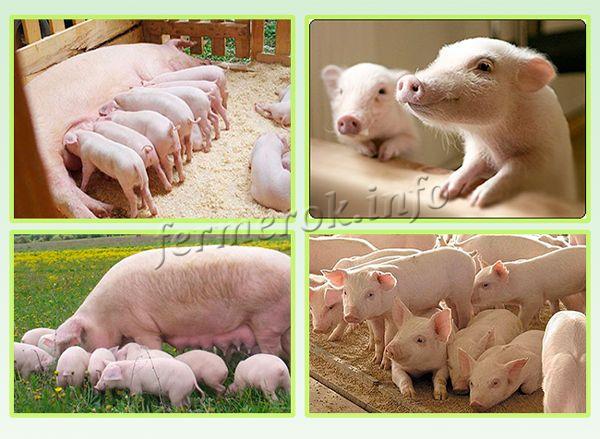

Pig breeding Landrace
Pregnancy lasts 114 days. During labor, the Landrace sow needs the help of a breeder or a qualified veterinarian. Each pig must be washed, then the umbilical cord is cut and the place where it was cut with iodine is cauterized. Then the piglets are applied to their mother so that they drink milk. It is important to apply the piglets to the nipples no later than 45 minutes after birth!
Part of caring for Landrace pores is to monitor the health and condition of the young. If there is a lack of weight, additional feeding is necessary. This is usually required if there are a lot of piglets for one uterus. As an additional feed, you can use cow's milk with admixtures of essential vitamins. Weaning from the mother occurs on the 28th day of life. From this point on, you can transfer the piglets to solid food.
The sow and the young are kept separately, but in the same room. The fact is that, despite a good maternal instinct, a significant weight of a female can crush her own offspring when moving, therefore they are seated so that there is a partition between the pig and the piglets. During feeding (every 2-3 hours), it is removed, and the piglets are transferred to the mother.
Feeding
Landrace pigs have good hearing and distinguish melodies. Quiet melodic music will help improve the pigs' appetite.
These animals are picky about their food. The diet should include:
- dry food;
- juicy feed;
- compound feed.
The basic feed should be diluted with the following products:
- pumpkin;
- various vegetables;
- silage;
- hay;
- cake.
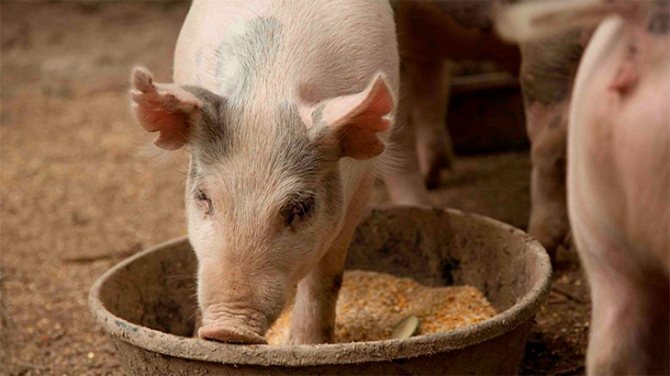

Pigs' nutrition should be complete and contain animal protein. The basis of nutrition should be compound feed, you can add whey, low-fat milk, fish or meat and bone meal to it. Also, thoroughbred animals need to be fed with alfalfa and root crops. Alfalfa can be given in large quantities. It stimulates digestion, increases milk production and fertility in sows.
Plants contain fiber, which provides:
- strengthening the immune system;
- feeling full;
- prevents the appearance of stomach ulcers.
It is not recommended to give rye, oats and corn, because these grains negatively affect bacon formation.
It is better to choose legumes, barley and wheat.
During the fattening of Landrace, the feeding regimen should be observed. If you feed often, the pigs will start to gain fat and subsequently get sick.
Correct Mode:
- In the summer, 2 times a day after 12 hours.
- In winter, 3 times a day after 8 hours.
To obtain high-quality bacon, all products must be divided into separate groups:
- Group 1 - cereals, silage, pumpkin.
- Group 2 - buckwheat, potatoes, corn bran.
- Group 3 - soy, cake, fish meal.
Group 3 is considered less preferable, because fishmeal gives the bacon an unpleasant odor.
It is recommended to include vitamin and mineral supplements in the diet.
Newborn piglets are fed by a sow. Feeding should be monitored. After each feeding, the piglets must be separated so that the mother can rest and eat.
If the sow does not have enough milk or she dies, then the newborns need to be given the first portion of colostrum to start the stomach.
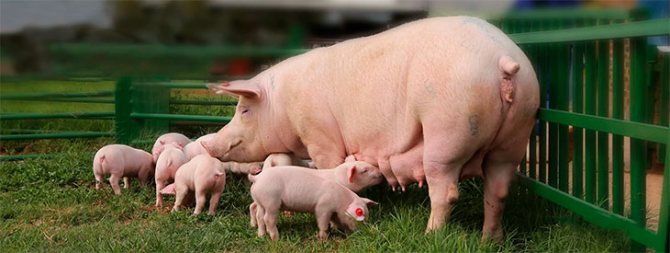

Then the piglets are transferred to artificial or mixed nutrition. Artificial feed should be given in portions of no more than 50 g. Feed should be done around the clock in 1.5 hours. Top dressing should be warm. It contains cow's milk, egg, sugar. Vitamin supplements can be given.
Newborn piglets need to be fed only high quality products, they are painfully tolerant of poor feed. And the sow's milk may go bad.
The bacon feed is divided into 2 parts:
- 1 period lasts up to 5 months. At this time, it is important to create good conditions for the animals. The weight of a 5 month old pig should be 58 kg.
- During the 2nd period, the daily weight gain should be 600 g. The weight of a 7 month old animal is 95 kg. Low gain reduces the quality of the bacon and makes it coarse and tough. At this stage, feeds that reduce the quality of the meat should be excluded.
How to choose piglets when buying
When choosing a pig of the Landrace breed, you need to pay attention to its condition:
- Young animals are purchased when they reach the age of 2 months.
- The piglet must be well-nourished and of strong build.
- The skin should be smooth and pink without damage. The bristles are silky, the tail is dry and clean.
- A straight snout profile indicates strong bones. In this case, the back is convex, the chest is deep and wide.
- The limbs are strong and wide apart and the hooves are shiny and clean.
- Lung disease is indicated by the breathing of a piglet. If he is coughing and breathing heavily, it is better to choose another.
- A healthy and well-developed piglet, which is 3-4 weeks old, weighs 5 to 7 kg.
- The piglet must be active.
- If the pig's back is inflamed and in feces, then it means that it has problems with the gastrointestinal tract.
- The animal must have no discharge from the eyes. The penny should be pink.
- The pig must have a veterinary passport, which indicates the vaccinations.
The Landrace breed is characterized by a long body, such pigs will grow faster. A sagging back, as well as thin and crooked legs, indicate deficiencies in the constitution of the body.
Reviews of livestock breeders
The experience of breeders raising Landrace gilts is rich in remarkable reviews. Breeders note that with the same feeding of ordinary pigs and Landrace pigs, the latter gain weight much faster. Most often, by the time of slaughter, a simple pig is gaining 150 kg, and a thoroughbred one as much as 250 kg. Moreover, in animals of the Landrace breed, the thickness of the sebaceous layer does not exceed 2.5 cm.
This breed does not withstand hot sunny weather. There were cases when pigs fainted from overheating without a canopy while walking.
Farmers who grow the breed at home confirm the good-natured nature of the pigs, and also talk about the fact that the Landrace breed likes to frolic for a long time in nature.
Sometimes you can find negative reviews on the Internet, in which you can feel the breeders' crushing that it is difficult to select food for animals. Others lament the need for careful grooming. However, in general, the breed is highly appreciated due to its early maturity, weight gain and excellent meat characteristics.

